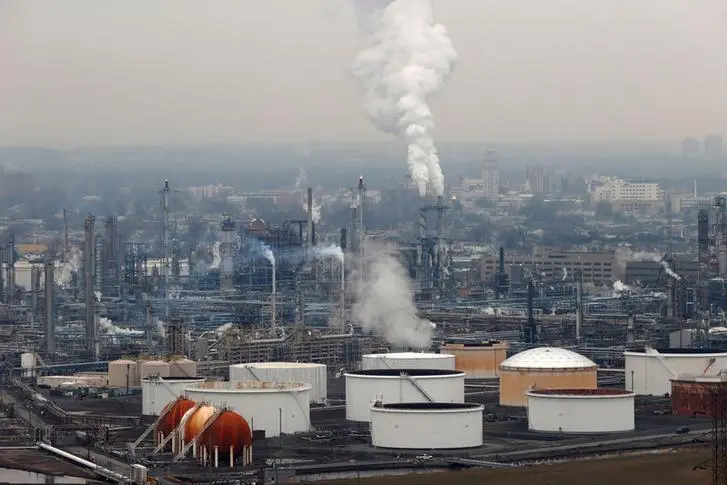PHOTO
LONDON - U.S. oil refineries have been processing petroleum at the fastest rate for the time of year since before the pandemic, but rising fuel inventories have begun to weigh on crack spreads and likely signal a slowdown ahead.
Refineries processed 17.5 million barrels per day (b/d) of crude and other feedstocks over the week ending on June 7, the fastest seasonal rate since 2018, according to data from the U.S. Energy Information Administration (EIA).
Refineries were employing 95% of their operable capacity, up 94% last year, and the highest percentage since 2019, weekly data from the EIA show.
But intensive processing is producing more gasoline and diesel than is being used domestically and exported – resulting in a persistent accumulation of stocks.
Gasoline inventories had climbed to 234 million barrels on June 7 compared with 221 million barrels in 2023 and 218 million in 2022.
Stocks were 1 million barrels (+1% or +0.10 standard deviations) above the prior 10-year seasonal average, erasing a deficit of 6 million barrels (-3% or -0.87 standard deviations) two months earlier.
Chartbook: U.S. fuel inventories and cracks
Distillate inventories had climbed to 123 million barrels compared with 114 million in 2023 and just 110 million in 2022.
Distillate stocks were still 10 million barrels (-8% or -0.50 standard deviations) below the 10-year average but the deficit had narrowed from 18 million barrels (-13% or -1.09 standard deviations) at the start of March.
Refineries have been responding to relatively high refining margins but the accumulation of stocks has now undermined them and likely indicates less frenetic processing in the weeks ahead.
The gross margin from turning 3 barrels of crude into 2 barrels of gasoline and 1 barrel of diesel, known as the 3-2-1 crack spread, has averaged $24 per barrel so far in June down from $31 in March.
The inflation-adjusted 3-2-1 crack spread is now exactly in line with the average for the 10 years before the pandemic, indicating the fuel market is comfortably supplied.
HURRICANE PREPARATIONS
The Atlantic hurricane season which runs from June to November is expected to be more active than normal in 2024 as result of conditions across the Atlantic and Pacific oceans.
In the Atlantic, sea surface temperatures are already warmer than normal for the time of year, creating conditions for a greater number of more intense tropical storms, including severe hurricanes.
In the Pacific, El Nino has already faded and forecasters expect La Nina conditions to form over the second half of the year, which will also promote a more active Atlantic hurricane season.
Even so, the risk of major disruption to the major refineries on the coast of Texas and Louisiana, where almost half of the country's processing capacity is located, remains low in absolute terms.
But the forecast of an active hurricane seasons means it will be relatively higher than usual, especially around the most intense part of the storm season in August and September.
Other things being equal, the market needs to carry slightly higher inventories to offset the increased risk of refinery disruptions.
But inventories cannot continue building at the recent rate without putting further downward pressure on margins and prices.
TAPPING THE REFINERY BRAKES
Hedge funds and other money managers have already anticipated fuel markets will be oversupplied, selling futures and options equivalent to 52 million barrels of gasoline and 13 million barrels of diesel over the last eight weeks.
In gasoline, the net position was cut to just 33 million barrels (24th percentile for all weeks since 2013) on June 4 from 85 million barrels (88th percentile) on April 9.
In diesel, the fund position had been transformed into a net short of 4 million barrels (24th percentile) from a long of 9 million (41st percentile).
Fund sales have likely anticipated, accelerated and amplified the downward pressure on refinery margins over the last two months.
Weaker margins will likely cause refineries to pull back slightly over the early part of the summer limiting the eventual inventory build.
Fuel consumption in the United States and the rest of the world has so far increased by much less than expected in the second quarter which has contributed to the pull back in petroleum prices.
OPEC⁺ is forecasting much stronger growth in the third quarter to draw down oil inventories, boost prices and enable producers to increase output starting from the fourth quarter.
But there are no indications of a big increase in fuel consumption yet, which is contributing to the downward slide in prices and spreads.
John Kemp is a Reuters market analyst. The views expressed are his own. Follow his commentary on X https://twitter.com/JKempEnergy
(Editing by David Evans)





















